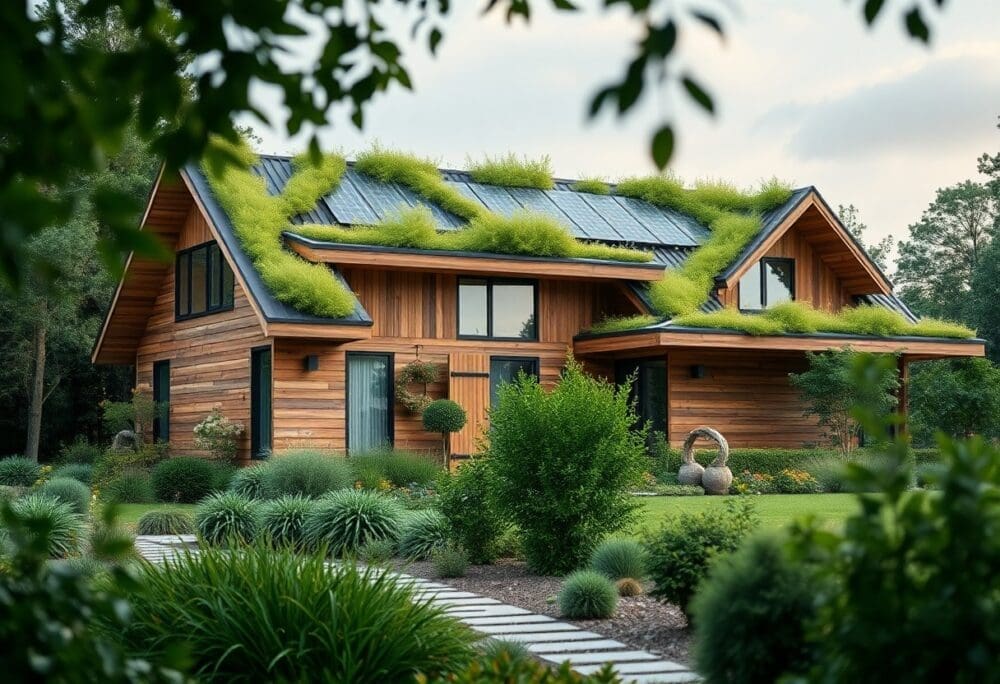You have a unique opportunity to enhance your home’s sustainability through innovative roofing trends that cater to eco-friendly living. As more homeowners prioritize environmentally conscious choices, understanding these trends can help you make informed decisions that benefit both your property and the planet. From green roofs and solar-integrated shingles to recycled materials and energy-efficient designs, you will discover how modern roofing solutions can significantly reduce your carbon footprint while elevating your home’s aesthetics and functionality.
Key Takeaways:
- Eco-friendly materials such as recycled shingles and metal roofing are gaining popularity for their durability and reduced environmental impact.
- Green roofing solutions, including living roofs, help improve insulation, promote biodiversity, and manage stormwater effectively.
- Energy-efficient systems, like solar panels integrated with roofing designs, are increasingly being adopted by homeowners to minimize energy consumption and lower utility bills.
The Importance of Sustainable Roofing
For eco-conscious homeowners, sustainable roofing represents not just an upgrade, but a commitment to environmental stewardship. By choosing eco-friendly materials and techniques, you reduce your home’s carbon footprint while enhancing its value and longevity. Sustainable roofs not only offer aesthetic benefits but also contribute to a healthier planet, making a positive impact for future generations.
Environmental Impact
Any homeowner can appreciate the benefits of reducing their environmental impact. Sustainable roofing materials are often made from recycled content and can be recycled at the end of their life cycle. By opting for these materials, you assist in preserving natural resources and minimize waste in landfills, contributing to a cleaner and greener environment.
Energy Efficiency
Against traditional roofing options, sustainable roofs can significantly improve energy efficiency in your home. They are designed to reflect sunlight and absorb less heat, ultimately lowering your energy consumption and reducing utility bills.
It is imperative to understand that energy-efficient roofing systems, such as cool roofs or solar shingles, can help maintain a consistent indoor temperature. Consequently, this can lead to decreased reliance on heating and cooling systems, promoting energy savings and a lower environmental footprint. Investing in energy-efficient roofing not only benefits you financially but also enhances your home’s overall comfort and sustainability.
Popular Sustainable Roofing Materials
Clearly, as the demand for environmentally friendly homes rises, various sustainable roofing materials are becoming increasingly popular. You can choose from a range of options that not only minimize your ecological footprint but also enhance your home’s energy efficiency and aesthetic appeal. From recycled shingles to living roofs, these materials offer versatility and durability while aligning with your sustainability goals.
Metal Roofing
Behind the uptick in sustainable roofing trends, metal roofing stands out for its longevity and recyclability. You can benefit from its ability to reflect solar heat, which can lower your energy bills. Additionally, metal roofs are available in a variety of styles and colors, ensuring that aesthetic considerations do not compromise your commitment to sustainability.
Green Roofs
With green roofs gaining popularity, you can transform ordinary rooftops into lush, living spaces. These systems involve layers of vegetation, soil, and a waterproof membrane, enabling you to grow plants while enhancing insulation and reducing urban heat. The added greenery not only beautifies your home but also supports biodiversity and reduces stormwater runoff.
Hence, integrating a green roof can significantly contribute to your overall sustainability strategy. By opting for this solution, you create a habitat for pollinators, improve air quality, and provide natural insulation for your home. Moreover, green roofs can increase your property value and offer unique outdoor recreational opportunities right in your own backyard. This innovative approach marries aesthetics with functionality, showcasing your commitment to environmental stewardship while enhancing your living space.
Cool Roofing Technologies
Many eco-conscious homeowners are discovering the benefits of cool roofing technologies, designed to reflect sunlight and reduce heat absorption. By incorporating these methods into your roofing system, you can lower energy costs and create a more comfortable living environment. This not only decreases your dependency on air conditioning but also promotes a healthier planet by minimizing your carbon footprint.
Reflective Coatings
An effective option for enhancing your roof’s energy efficiency is the application of reflective coatings. These specialized paints or surface treatments increase your roof’s albedo, allowing it to reflect more sunlight and absorb less heat. This can lead to a significant reduction in your cooling costs, ensuring your home stays comfortable during the warmer months.
Insulation Solutions
Solutions for improving your roof’s insulation can maximize energy efficiency and enhance comfort in your home. Implementing high-quality insulation materials helps to regulate temperature, keeping your space warmer in winter and cooler in summer, all while minimizing energy consumption.
At the core of effective insulation solutions are materials like spray foam, fiberglass, and cellulose, each offering unique benefits. Spray foam provides superior air sealing and thermal resistance, making it ideal for attics and hard-to-reach areas. Fiberglass insulation is lightweight and cost-effective, while cellulose, made from recycled materials, adds an eco-friendly aspect to your roofing system. Selecting the right insulation solution will ensure that your home remains energy-efficient, reducing utility bills while fostering a sustainable lifestyle.
Recycled and Upcycled Roofing Options
Unlike traditional roofing materials, recycled and upcycled options are gaining traction among eco-conscious homeowners. These sustainable choices not only minimize waste but also enhance the aesthetic appeal of your property. By exploring solutions like recycled shingles and upcycled materials, you can embrace a greener lifestyle. For more insights into sustainable roofing trends, check out Embracing the Future of Sustainable Roofing: Trends and Insights ….
Recycled Shingles
Shingles made from recycled materials, such as rubber, plastic, and even reclaimed wood, are an excellent choice for your eco-friendly roof. These shingles not only reduce landfill waste but also provide durable and weather-resistant solutions for your home. They can mimic the appearance of traditional roofing options, ensuring your home remains stylish while you contribute positively to the environment.
Upcycled Materials
Any homeowner can appreciate the benefits of upcycled roofing materials, which is derived from repurposed products like metal, slate, or tile. These materials not only reduce resource consumption but also add unique character to your roof, giving it an individual flair.
Another advantage of using upcycled materials is their potential cost-effectiveness. Since they often originate from discarded items, you might find that opting for upcycled options can save you money while benefiting the environment. Furthermore, many upcycled materials are built to withstand harsh weather conditions, ensuring longevity and reducing the need for frequent replacements. Embracing these innovative materials allows you to make a bold statement about your commitment to sustainability while enhancing the overall aesthetic of your home.
Choosing the Right Roofing Contractor
Your choice of roofing contractor can significantly impact the success of your sustainable roofing project. Ensure that you select a contractor experienced in eco-friendly materials and practices, as they will be better equipped to guide you through your options. It’s important to verify their local reputation, ask for references, and ensure they prioritize sustainability in their work.
Qualifications and Certifications
Against the backdrop of a growing market for sustainable roofing, it is imperative to look for contractors who possess relevant qualifications and certifications. These credentials not only demonstrate a commitment to sustainability but also indicate that the contractor is knowledgeable about the best practices and materials in the eco-friendly roofing sector.
Evaluating Experience with Sustainable Practices
Any contractor worth your consideration should showcase their experience with sustainable roofing practices. Look for examples of past projects, customer testimonials, and specific instances where they have implemented eco-friendly solutions effectively.
Indeed, evaluating a contractor’s experience with sustainable practices allows you to gauge their expertise in navigating the unique challenges of eco-friendly roofing. Ask about their familiarity with materials like recycled shingles, solar panels, or green roofing systems. This insight not only helps you feel more secure in your choice but also ensures that your roofing project aligns with your environmental goals. The right contractor will have a portfolio that reflects their commitment to sustainable practices and a reputation for delivering high-quality results.
Financial Considerations for Eco-Friendly Roofing
Keep in mind that while eco-friendly roofing options may have higher initial costs, they can yield significant long-term financial benefits. Investing in sustainable materials and technologies can often lead to lower energy bills, reduced maintenance costs, and improved property value. Assessing your budget and evaluating potential returns can help you make an informed decision that aligns with your financial goals.
Cost-Benefit Analysis
Any investment in eco-friendly roofing requires a thorough cost-benefit analysis to understand its value over time. It’s important to factor in not just the installation costs, but also the savings you might experience through energy efficiency, lower insurance premiums, and longer lifespan of sustainable materials. A detailed assessment can reveal whether the initial expenses are outweighed by the potential savings and increased home equity.
Incentives and Rebates
An easy way to offset the cost of eco-friendly roofing is to take advantage of available incentives and rebates. Many local and federal programs offer financial assistance or tax breaks for homeowners who invest in sustainable building practices, including energy-efficient roofing materials. Research what options are available in your area to help reduce upfront costs and improve overall affordability.
CostBenefit incentives are designed to encourage you to invest in sustainable solutions by providing financial rewards. These incentives can vary widely, including tax credits, grants, and low-interest loans specifically for eco-friendly home improvements. By exploring these programs, you can significantly lower your financial burden and enhance the viability of sustainable roofing projects tailored to your needs. Be sure to check relevant government websites and local organizations for specific offerings and eligibility requirements.
Q: What are the most popular sustainable roofing materials available for eco-friendly homeowners?
A: Eco-friendly homeowners can choose from a variety of sustainable roofing materials, including metal roofing, recycled shingles, clay tiles, and green roofs. Metal roofing is highly durable and reflects solar heat, reducing energy costs. Recycled shingles, made from post-consumer waste, help reduce landfill contributions and are available in a variety of styles. Clay tiles are both aesthetically pleasing and energy-efficient, with a long lifespan. Green roofs, which feature living vegetation, provide insulation, reduce stormwater runoff, and support biodiversity.
Q: How can sustainable roofing contribute to energy efficiency in homes?
A: Sustainable roofing can significantly enhance a home’s energy efficiency in several ways. Many eco-friendly roofing materials come with reflective coatings that help reduce heat absorption, which can lower cooling costs in warmer climates. Additionally, green roofs provide natural insulation, keeping homes cooler in summer and warmer in winter. Proper installation of energy-efficient materials also contributes to better ventilation and reduced energy consumption for heating and cooling, leading to lower utility bills and a reduced carbon footprint.
Q: What are some maintenance tips for maintaining a sustainable roof?
A: Maintaining a sustainable roof involves regular inspections and care to ensure longevity and performance. Homeowners should clean gutters biannually to prevent water damage and check for debris buildup on the roof surface. It’s vital to inspect for any signs of damage or wear, such as cracked tiles or rust spots on metal roofing. For green roofs, regular watering and care for the vegetation are necessary to ensure that the ecosystem remains healthy. Lastly, consider consulting with a roofing professional for periodic assessments to address any potential issues early on.





